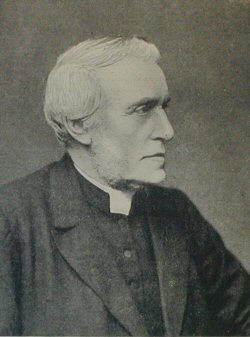 REV. JAMES BLACK
REV. JAMES BLACK REV. JAMES BLACK
REV. JAMES BLACK AFTER Glasgow Cathedral itself, perhaps the most beautiful
fane within the city is Wellington U.F. Church in University Avenue. Every day
during the college session hundreds of students look across the way at its Greek
portico and fine proportions, and gather from its satisfying lines a more
striking illustration of classic architecture and taste than might be got from
the reading of many books. The story of the congregation, too, is of high
interest. A branch of the original Anti-Burgher congregation of Glasgow, which
worshipped in the Havannah and is now represented by Cathedral Square U.F.
Church, it built its first plain kirk in Cheapside Street, Anderston, in 1792.
The graveyard which grew about it is still to be seen. In 1827 the congregation
removed to Wellington Street, to a church whose architect, John Baird, was no
more than 28 years of age, but whose Ionic portico is still much admired. Much
of the cost was defrayed by the sale of burial crypts below the church. Fifty
years later, when the congregation resolved to remove to Hillhead, an Act of
Parliament had to be procured for the wholesale transfer of the dead, and some
eight hundred bodies had to be reinterred in the Necropolis and elsewhere,
before the title of the property was freed from incumbrance, and the church
could be sold. The present church and its site in University Avenue cost
£26,468, and the architect was Mr. T. L. Watson.
Dr. Black, the senior minister of the church, was born in
Berwickshire in 1826, and received his early education at a parish school.
During the four sessions in which he studied subsequently at Edinburgh
University, he took a distinguished place in several of his classes, and at the
end of his five years' study in the U.P. Divinity Hall he was no sooner licensed
than he received a call to Urr, in Kirkcudbrightshire. Three years later, in
1857, he was transferred to St. Andrews, and when he removed to Wellington
Street Church, Glasgow, in 1868, the University of St. Andrews conferred on him
the degree of D.D. He came as colleague to the venerable Dr. Robson, and from
the death of the latter in 1872 till 1894 he carried on the work of the
congregation alone. During that period, in 1884, the congregation successfully
accomplished its great venture of removing to University Avenue, and in 1802 Dr.
Black was unanimously chosen Moderator of the Supreme Court of the United
Presbyterian Church, and was sent by it as a deputy to the fifth General Council
of the Alliance of Reformed Presbyterian Churches which met that year at
Toronto. Since 1894 Dr. Black has had in succession as colleagues the Rev. D. W.
Forrest, M.A., and the Rev. George Morrison, M.A.
Apart from the affairs of his own congregation Dr. Black has
taken an active part in the work of the U.P. and U.F. Churches, as well as of
several Christian and benevolent institutions. He is a Director of the National
Bible Society, and was for many years a Patron of Hutchesons' Hospital and a
Director of Anderson's College. In 1880 he spent four months in visiting Egypt,
and in travelling over the Desert of Sinai and through Palestine. Besides
special sermons from time to time printed by request, and contributions to
various periodicals, he has been the author of "The Christian Life," an
exposition in two volumes of Bunyan's "Pilgrim's Progress."
At the centenary of the congregation, and the occasion of his
own semi-jubilee as its minister, in 1893, Dr. Black was presented with an
address and a testimonial of £1,625, while Mrs. Black received a silver tea tray
and a diamond ring. In 1904 the jubilee of his ministry was celebrated, when
several addresses were presented to him, along with another testimonial of
£1,000 from the congregation. Dr. Black is still able to take his share of
preaching in Wellington Church.
Back to
Index of Glasgow Men (1909)